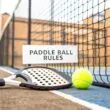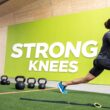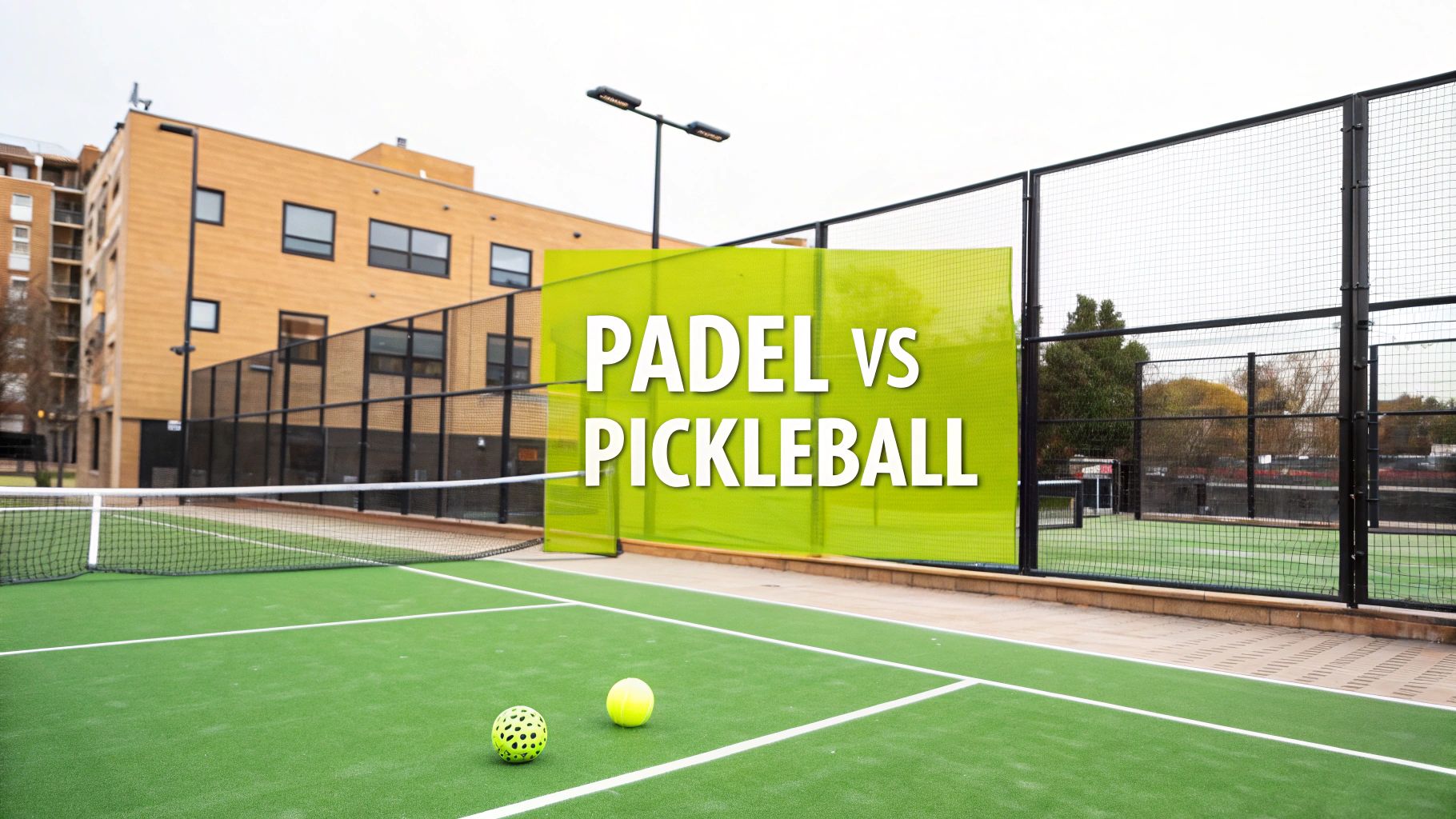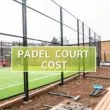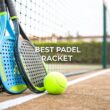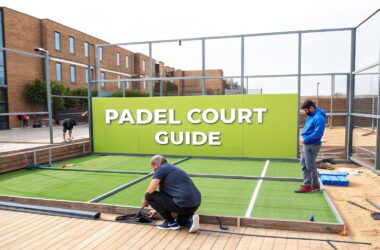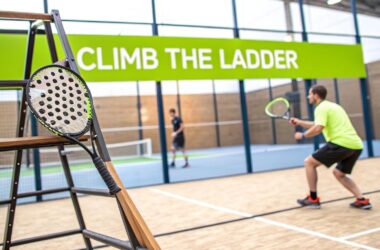Think two racket sports exploding in popularity are the same? Think again. The biggest split between padel and pickleball comes down to the court itself and the style of play it creates.
Padel is all about longer rallies on a larger, glass-enclosed court where you can play shots off the walls. Pickleball, on the other hand, happens on a smaller, open court with a non-volley zone right at the net, which forces quick, reflex-based exchanges.
Padel vs Pickleball A Quick Comparison
While they both look fun and social, the on-court experience couldn't be more different. Your choice really boils down to what you enjoy more: the strategic, wall-bouncing chess match of padel or the fast-paced, volley-heavy action of pickleball.
It's a common question we hear: is padel the same as pickleball? The simple answer is no. Each sport has a unique DNA shaped by its court, its gear, and its rules. This image gives you a great visual starting point for the core differences.

Buy the best padel gear to level up your next game!
CHECK OUT this deal from Padel Market!Get ready to take your game to the next level with the latest padel gear from Padel Market! Fast EU and Worldwide Shipping
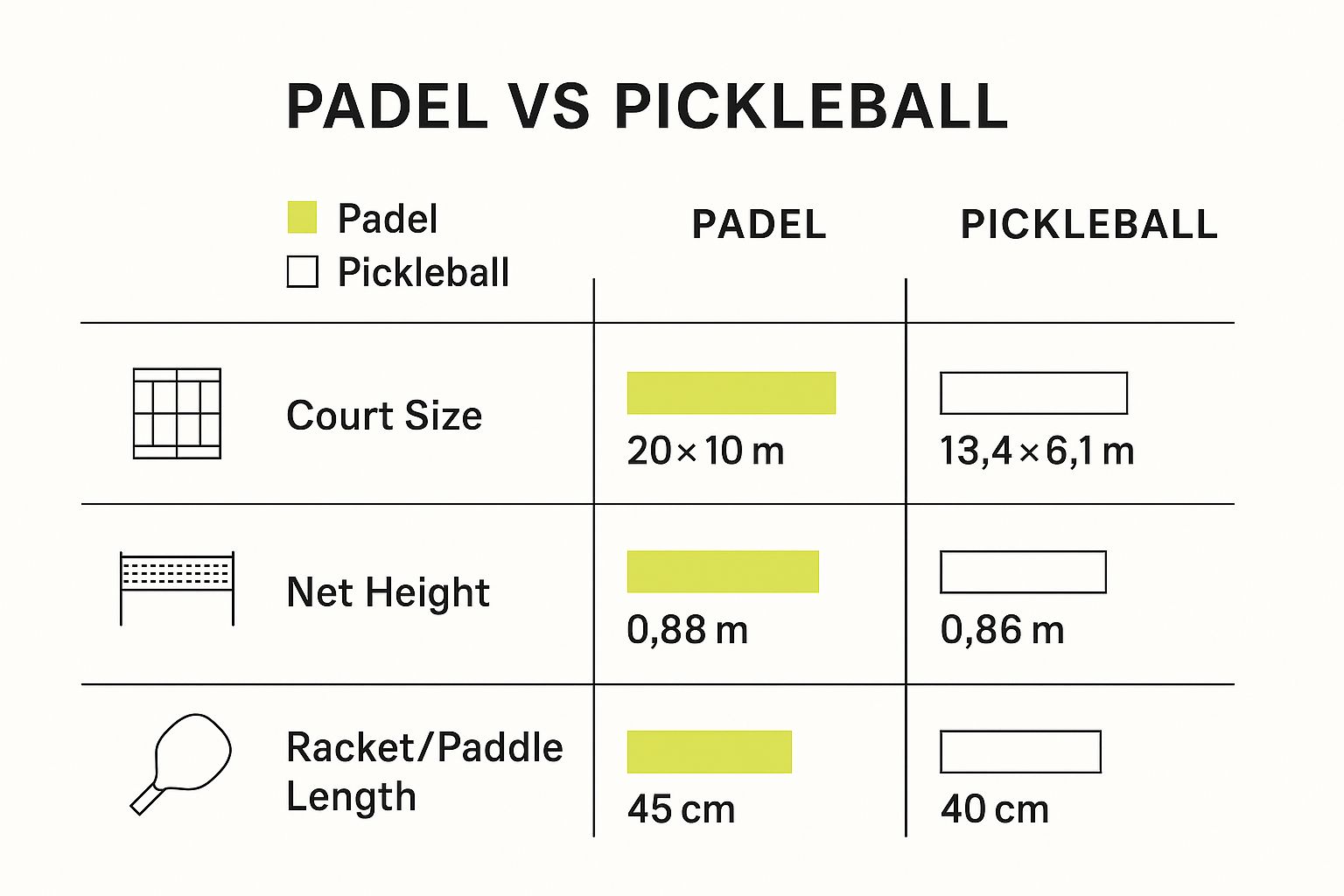
As you can see, the padel court is a much bigger playground, though the rackets themselves aren't worlds apart. To really break it down, let's look at the key differences side-by-side.
Key Differences at a Glance Padel vs Pickleball
This table strips away the noise and gives you a clean comparison of what makes each sport tick.
| Feature | Padel | Pickleball |
|---|---|---|
| Court Size | 20m x 10m with glass walls | 13.4m x 6.1m, open court |
| Ball Type | Depressurized tennis ball | Perforated plastic ball |
| Racket/Paddle | Perforated, stringless composite | Solid, stringless composite |
| Scoring | Tennis-style (15, 30, 40) | Side-out scoring to 11 |
| Key Rule | Walls are in play | Non-volley zone ("kitchen") |
From the court dimensions to the scoring system, these details create completely different games. The walls in padel add a strategic layer you won't find anywhere else, while pickleball's "kitchen" dictates the flow of every point at the net.
Comparing Court Dimensions and Equipment
Right off the bat, the most striking difference between padel and pickleball is the court itself. A padel court is basically a glass-and-mesh cage measuring 20 meters by 10 meters. Those walls aren't just for show; they're an active part of the game, letting you play ricochets and bank shots. It creates a full 360-degree playing field where strategy gets a lot more creative than just hitting it over the net.
Pickleball, on the other hand, is played on a smaller court that’s the same size as a badminton court: 13.4 meters by 6.1 meters. It’s a wide-open space with no walls, which means the game is all about net play, precise positioning, and hitting direct shots. This basic difference in the playing environment really dictates the whole vibe of each sport.
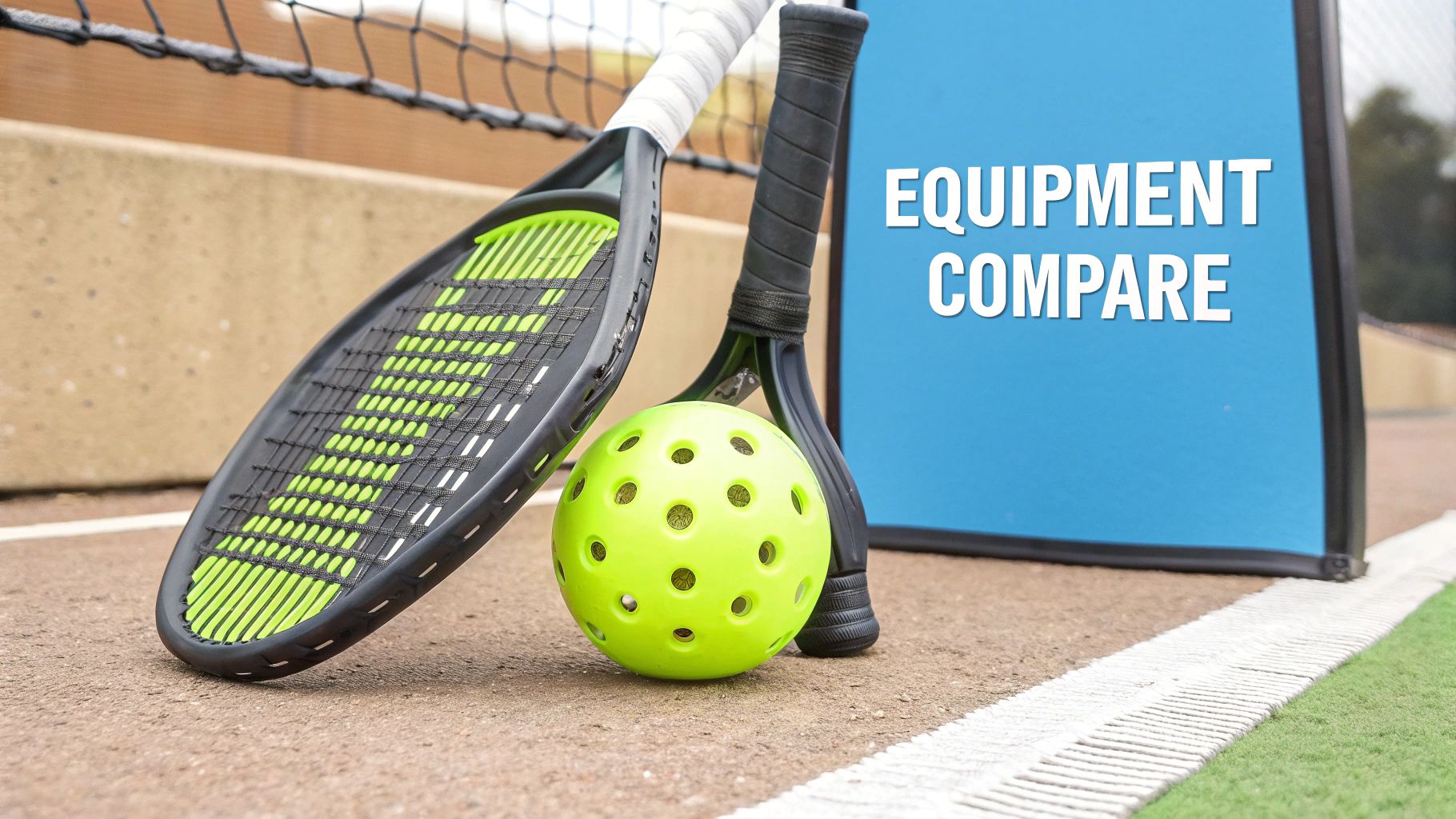
Paddles and Balls
The gear is just as different as the courts. Padel rackets are solid, stringless paddles with holes punched through them. They have a thick foam core designed to give you power while controlling a depressurized tennis ball. This build is all about hitting forceful shots and absorbing the impact from a heavier ball.
Pickleball paddles are much lighter, solid, and often thinner, built for quick hands and finessed shots at the net. You use them to hit a perforated plastic ball—think of a wiffle ball—that moves slower and doesn't bounce as high. The paddle's design is focused on maintaining control during those fast-paced dink rallies right at the net.
The core difference in equipment comes down to purpose: Padel gear is built for power and endurance in long, wall-assisted rallies, while pickleball gear is optimized for speed, precision, and quick reflexes in a confined space.
This clear split in courts and equipment also shows up in how each sport is growing. Padel has exploded in the US, jumping from fewer than 20 courts in 2019 to 454 courts by 2023. But with around 100,000 American players, it’s still trailing pickleball’s massive estimated 5 million player base. It just goes to show how much court availability can influence a sport's dominance in a region. You can dig deeper into padel’s journey in the US over at PadelUSA.com.
A Closer Look at Rules and Scoring Nuances
Beyond the court dimensions and gear, the real heart of the Padel vs. Pickleball debate lies in their unique rules and scoring systems. Both sports kick things off with an underhand serve, but how they get the point started couldn't be more different. It's the first clue that you're playing two fundamentally separate games.
In Padel, the server has to bounce the ball once behind the service line before hitting it at or below their waist. It’s a rhythmic, predictable start to what's often a fast-paced rally. Pickleball, on the other hand, uses a drop serve hit straight out of the air—no bounce needed. This simple difference introduces a lot more variation right from the get-go.
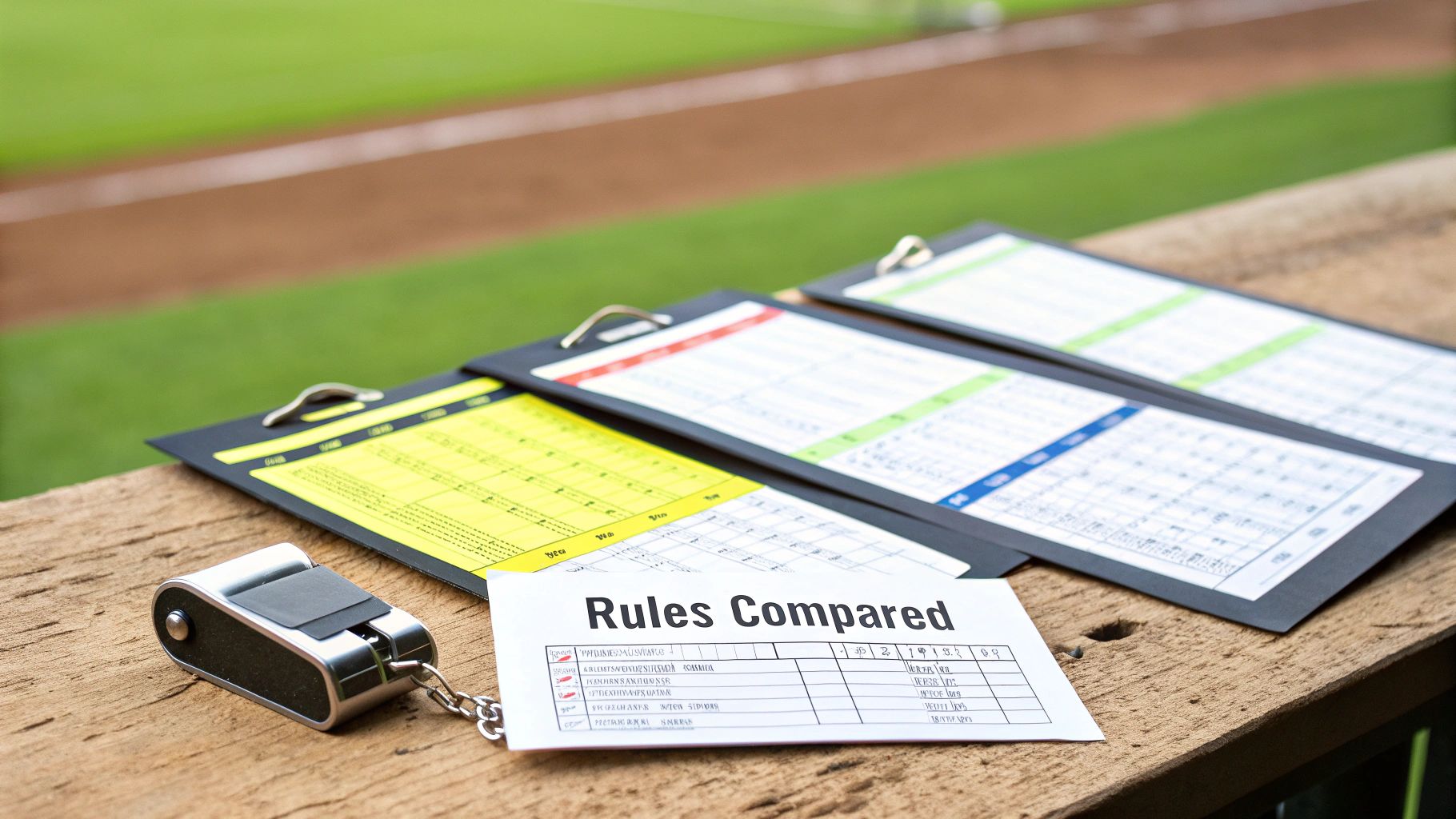
Scoring Systems and Game-Defining Rules
This is where the two sports really go their separate ways. Padel borrows its scoring directly from tennis, using the familiar 15, 30, 40, game system. If you've ever watched or played tennis, you'll feel right at home. This format creates high-stakes moments like deuce and break points that build tension. To get the full rundown, you can check out these detailed paddle tennis rules that break down every aspect of match play.
Pickleball completely throws that out the window. It uses a side-out scoring system where you can only score a point when your team is serving. Games are played to 11 points (and you have to win by two), which means getting the serve back is just as important as winning a rally.

Buy the best padel gear to level up your next game!
CHECK OUT this deal from Padel Market!Get ready to take your game to the next level with the latest padel gear from Padel Market! Fast EU and Worldwide Shipping
The single biggest rule difference, and the one that truly defines pickleball strategy, is the 'kitchen.' This is a seven-foot non-volley zone on each side of the net where you are absolutely forbidden from hitting the ball out of the air. Padel has no equivalent.
That kitchen zone is everything in pickleball. It forces players into soft, strategic shot exchanges known as "dinking," preventing anyone from just running to the net and smashing everything. It dictates your positioning, your shot selection, and the entire rhythm of the game. Padel’s wide-open court, with no such zone, encourages aggressive net play and lets players volley from anywhere, feeding into its more power-driven style.
Gameplay Feel and Strategic Demands
Forget the rules and equipment for a second. The real difference between padel and pickleball comes down to how each game feels. They’re built on completely different strategic philosophies, offering two unique athletic challenges. One is a game of patience and 3D chess; the other is all about lightning-fast reflexes and explosive, quick-fire points.
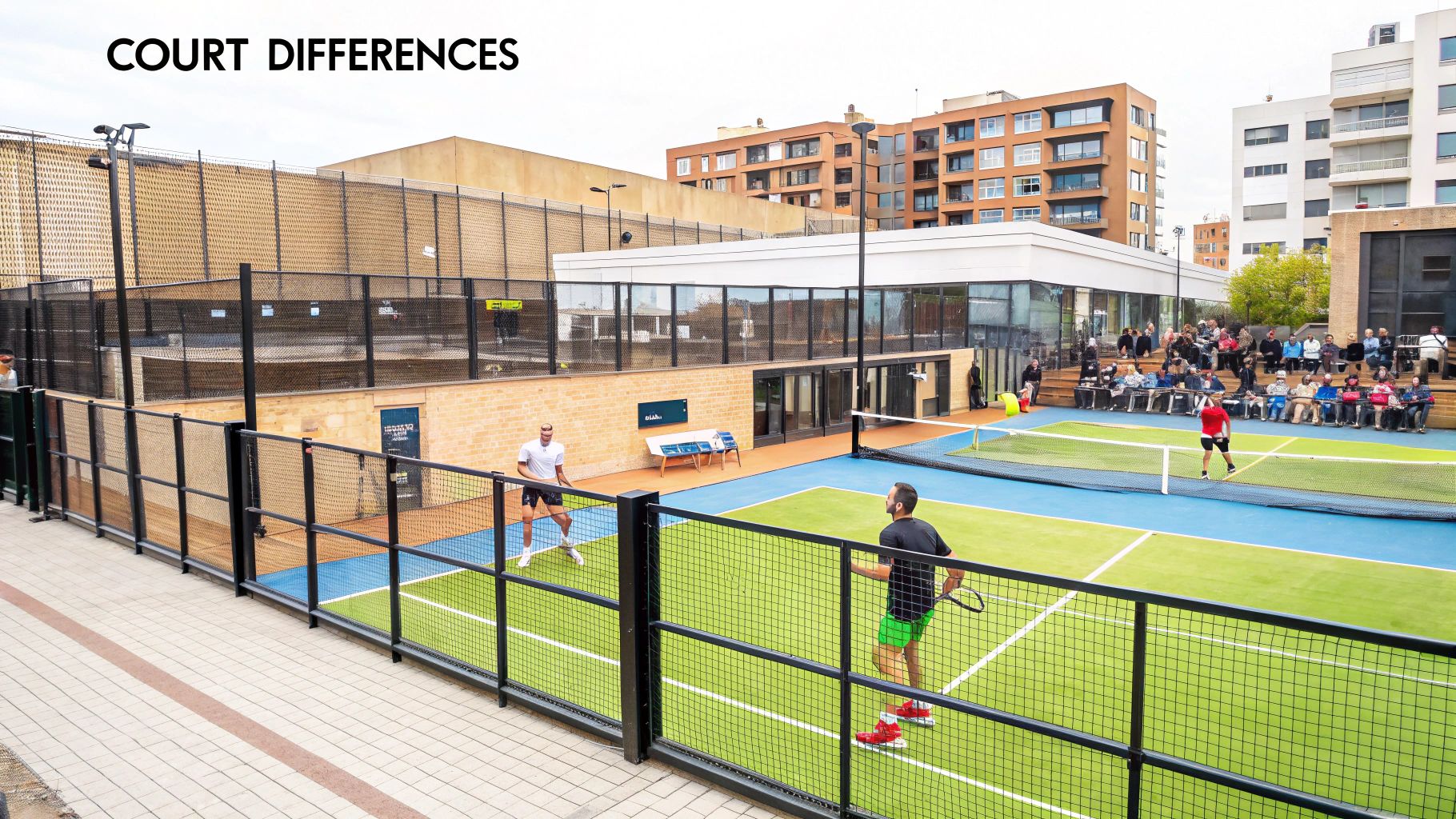
Padel is, at its core, a game of strategic patience. Think of it like a high-speed chess match where the glass walls aren't just boundaries—they're part of the board. You can use them for defensive lobs and crafty angles, which naturally extends the rallies. This forces you and your partner to constantly solve a spatial puzzle, making teamwork and tactical positioning absolutely essential.
Pickleball, on the other hand, is a game of rapid-fire exchanges and pinpoint precision. The action is almost entirely focused around the non-volley zone (the "kitchen"), where players get into soft, controlled "dinking" battles. This intense, close-quarters combat demands incredible hand-eye coordination and twitch-like reflexes. It’s a pure test of reaction time and shot placement.
Strategic Scenarios Compared
To really get a feel for the difference, let’s look at how a typical point might play out in each sport:
- Defensive Play in Padel: An opponent smashes the ball hard. In many racket sports, that's game over. In padel, you can just let the ball bounce off the back glass, which buys you precious time to get back in position and send up a defensive lob, completely flipping the momentum of the rally.
- Offensive Play in Pickleball: The main objective is to force an error at the kitchen line. A winning play often starts with a series of perfectly placed dinks that pull your opponent off-balance, creating just enough space to hit a decisive, unreturnable volley.
The big takeaway is this: Padel strategy is about using the entire court—walls included—to outmaneuver your opponents in longer, more drawn-out points. In pickleball, the battle is won or lost in the small area around the net through sheer speed, control, and immediate reactions.
Ultimately, which one you prefer comes down to the kind of challenge you're looking for. If you love long, intricate points that reward tactical thinking and partnership, padel will feel like a natural fit. But if you crave a faster-paced game defined by quick hands, precision, and intense net battles, pickleball will give you all the action you can handle.
Understanding Cultural Roots and Global Growth
Every sport has a story, and the origins of padel and pickleball tell you a lot about their unique cultural identities. Pickleball got its start in an American backyard back in 1965, created by a few families just looking for a fun, easy game to play. That homegrown beginning is really the key to its identity as a social, community-first activity.
This accessible, just-for-fun nature is what fueled its explosion across the United States, turning it into the nation's fastest-growing sport. It’s absolutely thriving in community centers, retirement villages, and local parks, celebrated for its incredibly low barrier to entry and friendly vibe. The difference between padel and pickleball is crystal clear when you look at where each sport dominates geographically.
Padel, on the other hand, was born in a completely different setting: a resort in Mexico in the late 1960s. This gave it a much different trajectory from the start. It quickly found a seriously passionate following in Spain and Latin America, becoming a sporting giant in those regions long before it started making its way to the rest of the world.
Divergent Paths to Popularity
Padel’s growth has been immense, especially across Europe and the Middle East, where it has more of a club-centric culture. Pickleball's rise has been almost entirely a North American phenomenon, with more than 5,000 dedicated locations popping up across the US alone.
Meanwhile, by 2025, padel was being played in over 90 countries with an estimated 48,000 courts in Europe, which really shows its widespread international appeal. These separate growth stories explain why you might find one sport all over your local area and the other one is nowhere to be seen. If you want to dive deeper into how their popularity stacks up, check out this detailed breakdown of padel vs pickleball.
While pickleball's rise feels like a grassroots social movement in North America, padel's expansion has been more structured, following the established paths of international racket sports through federations and private clubs.
So, Which Racket Sport Is Right for You?
Deciding between padel and pickleball really comes down to what you're looking for in a sport—your personal goals, current fitness level, and what kind of vibe you enjoy most. You’ll want to think about the learning curve, how much of a workout you want, and even just how many courts are available near you.
Are you a former tennis player who misses the strategic rallies but could do with a little less running? If so, padel is probably your perfect match. It keeps the familiar scoring and strategic feel of tennis but adds a new tactical layer with the walls. It’s a game that rewards patience, shot placement, and teamwork through longer, more dynamic points.
On the other hand, are you just looking for something super social and easy to pick up, a game the whole family can be playing within minutes? Pickleball is calling your name. The smaller court and straightforward rules make it incredibly welcoming for all ages and athletic abilities.
Key Takeaway: If you crave the strategic depth and teamwork of a sport like tennis, go for padel. If you'd rather have a fast-paced, social game with quick net exchanges that’s easy to learn, pickleball is the clear winner.
One big practical thing to consider is where these sports are popular. Padel is a legitimate global sensation, with an estimated 30 million players and 60,000 courts spread across 130 countries. Pickleball, however, is a uniquely American phenomenon for now. It's the fastest-growing sport in the United States, with over 19.8 million players, which points to a huge regional preference. You can get a deeper dive on this trend over at The Dink Pickleball.
To get the most out of either sport, it helps to have a decent baseline of fitness. If you're new to working out, starting with some beginner-friendly workout routines will help you get ready for the court.
Common Questions Answered
Let's clear up some of the most common questions people have when comparing padel and pickleball. Getting these details straight will help you figure out which court you should hit up first.
Is Padel Harder to Learn Than Pickleball?
For a complete beginner, pickleball is almost certainly easier to pick up. You can start having fun rallies right away thanks to the smaller court, a ball that doesn't fly too fast, and a simple underhand serve.
Padel, on the other hand, has a bit of a steeper learning curve. The court is bigger, and figuring out how to use the glass walls to your advantage takes some practice. That said, anyone with a tennis background usually feels right at home on a padel court and picks it up very quickly.
Can I Use a Pickleball Paddle for Padel?
Absolutely not. The paddles for these two sports are worlds apart and definitely not interchangeable.
Padel paddles are thick, full of holes, and built to withstand the impact of a heavier ball and shots ricocheting off the glass. A pickleball paddle is way too light and would probably crack under that kind of pressure. Trying it the other way around doesn't work either—a padel paddle is too heavy and powerful for pickleball, so you'd have zero control over the ball.
The core difference in equipment comes down to impact and control. Each paddle is specifically engineered for the unique ball and court dynamics of its sport, making them unsuitable for the other.
Which Sport Offers a Better Workout?
Both sports will get your heart pumping and are a great form of cardiovascular exercise. It really just depends on what kind of workout you're looking for.
Padel usually involves more sustained running and quick side-to-side movements across a larger court, which often results in a more intense aerobic session. Pickleball is more about short, explosive bursts of movement, especially when you're playing up at the net, and it's generally easier on the joints. Ultimately, how much of a sweat you break comes down to your personal playing style.


